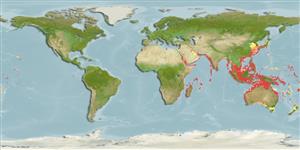Common names from other countries
Environment: milieu / climate zone / depth range / distribution range
Ekologi
Dasar (demersal); payau; kisaran kedalaman 0 - 100 m (Ref. 275). Tropical; 51°N - 48°S, 22°E - 155°W (Ref. 106950)
Indo-Pacific: from Japan to Australia and New Zealand coasts, from Hawaii to the East African coast, north to Red Sea and south to Madagascar. Introduced in the Mediterranean Sea.
Length at first maturity / Size / Weight / umur
Maturity: Lm ? range ? - ? cm Max length : 40.1 cm ML jantan/; (Ref. 121859); Berat maksimum terpublikasi: 1.80 g (Ref. 275)
Also caught by set nets and spears and jigs.
Life cycle and mating behavior
Kematangan | Reproduksi, perkembang biakan | Pemijahan | telur-telur | Fecundity | Larva
Members of the class Cephalopoda are gonochoric. Male and female adults usually die shortly after spawning and brooding, respectively. Mating behavior: Males perform various displays to attract potential females for copulation. During copulation, male grasp the female and inserts the hectocotylus into the female's mantle cavity where fertilization usually occurs. Life cycle: Embryos hatch into planktonic stage and live for some time before they grow larger and take up a benthic existence as adults.
rujukan utama
Acuan | Koordinator | mitra
Roper, C.F.E., M.J. Sweeney and C.E. Nauen. 1984. (Ref. 275)
Status IUCN Red List (Ref. 130435: Version 2024-1)
status CITES (Ref. 108899)
Not Evaluated
Not Evaluated
penggunaan manusia
Perikanan: komersial
FAO - Perikanan: landings | FishSource | Sea Around Us
Alat, peralatan
Sumber internet
Estimates based on models
Preferred temperature
(Ref.
115969): 23 - 29.1, mean 28 (based on 2210 cells).
Daya lenting
Tinggi, Waktu penggandaan populasi minimum kurang dari 15 bulan (K=0.73-1.25).
keancaman
Low vulnerability (19 of 100).
